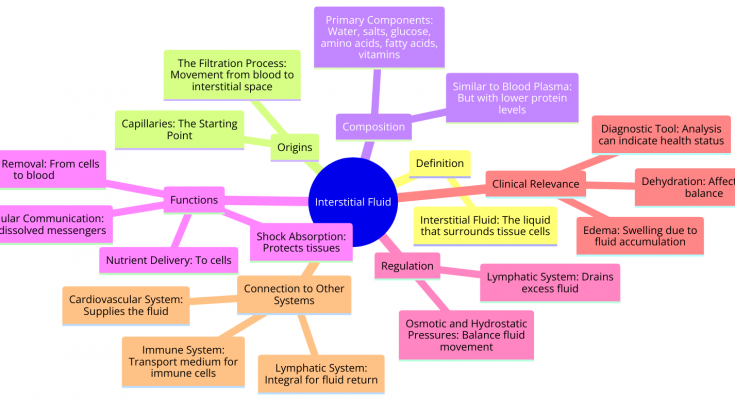Table of Contents
What is Interstitial Fluid?
Interstitial fluid, also called tissue fluid, is the fluid that fills the spaces between most of the cells of the body. It is a crucial component of the extracellular fluid, which includes all body fluids outside of cells.
Origin of Interstitial Fluid

Capillaries: The Starting Point
- Capillaries are the smallest and most numerous blood vessels in our body, forming a vast network that reaches almost every cell. They have thin, semi-permeable walls that allow them to perform a critical function: the exchange of substances between the blood and the body’s tissues.
The Filtration Process
- As blood travels through capillaries, the pressure inside these vessels pushes some components of the blood plasma through the capillary walls. This process is known as filtration. The components that pass through typically include water and small solutes like glucose, electrolytes (such as sodium and potassium ions), and oxygen. These substances are essential for cell survival and function.
Formation of Interstitial Fluid
- The fluid that filters out of the capillaries fills the spaces around the tissue cells, and this fluid is what we call interstitial fluid. It forms a thin layer surrounding each cell, providing the cells with a direct supply of nutrients and a way to dispose of waste products.

Composition and Characteristics of Interstitial Fluid
Similar Yet Different from Blood Plasma
- Interstitial fluid is similar to blood plasma in its basic composition but differs significantly in protein content. The semi-permeable nature of capillary walls means they allow water and small molecules to pass through but restrict the movement of larger molecules like proteins. As a result, interstitial fluid has much fewer proteins than blood plasma.
Primary Components
- The main components of interstitial fluid include water, which acts as a solvent for other substances, and ions, which are essential for various physiological processes. Small nutrients, vital for cell energy and function, dissolve in this fluid and are readily available to the cells. Gases such as oxygen and carbon dioxide are also present, ensuring that cells receive oxygen for metabolism and can expel carbon dioxide, a waste product of cellular respiration.
A Dynamic and Essential Fluid
- Interstitial fluid is not static; it constantly moves, driven by pressure differences and osmotic gradients. As it circulates, it exchanges substances with the blood through the capillary walls and with the cells, ensuring a continuous supply of nutrients and removal of wastes. This dynamic exchange keeps the tissue environment stable and supports the health and function of cells.
Role of Interstitial Fluid in the Body
Nutrient and Oxygen Delivery
- Interstitial fluid is instrumental in sustaining life at the cellular level. It acts as a delivery system, transporting vital nutrients and oxygen from the blood to the cells. This fluid permeates the spaces around cells, ensuring that these essential substances are within easy reach of every cell, no matter how distant from the nearest capillary.
Waste Removal
- Cells, during their normal functioning, produce waste products and carbon dioxide that need to be removed to prevent toxic buildup. Interstitial fluid collects these wastes and transports them away from the cells. This process is vital for maintaining a healthy cellular environment conducive to optimal cell function.
Buffering and Transport Medium
- Besides nutrient delivery and waste removal, interstitial fluid serves as a buffer, helping to maintain the pH and ionic balance in the tissue spaces. This balancing act is crucial for the proper functioning of cells and for protecting them from harsh changes in their environment.
Connection to the Lymphatic System
Collection by the Lymphatic System
- While a significant portion of the interstitial fluid is reabsorbed directly into the blood capillaries, not all of it makes this return journey. The excess fluid, which is not reabsorbed, is collected by the lymphatic system. This system comprises a network of vessels and nodes that are parallel to the blood circulatory system but are dedicated to transporting lymph .
Transformation into Lymph
- Once the interstitial fluid enters the lymphatic vessels, it is referred to as lymph. Lymph carries the fluid along with any proteins, waste products, and other substances it has collected from the tissue spaces.
Return to the Circulatory System
- The lymphatic system is not a closed loop but instead returns the lymph to the circulatory system. This return usually occurs at the junctions where the lymphatic vessels drain into the larger veins near the heart. Through this process, the lymphatic system plays a critical role in maintaining fluid balance in the body by ensuring that the fluid that leaves the bloodstream is eventually returned.
Role in Immune Defense
- The lymphatic system also plays a crucial role in the body’s immune defense. As lymph is transported through lymphatic vessels, it passes through lymph nodes, which filter the lymph and trap foreign particles like bacteria and viruses. Specialized cells within the lymph nodes then destroy these potentially harmful invaders, helping to protect the body from infections and diseases.
Also Check – 13 Important Differences between Lymph and Blood
Also Chekc – Key Organs of the Lymphatic System: Functions and Locations.
Also check – 15 Important Functions of Lymph
Also Check – Difference between Lymph and Plasma
Also Check – Composition of the Lymph
